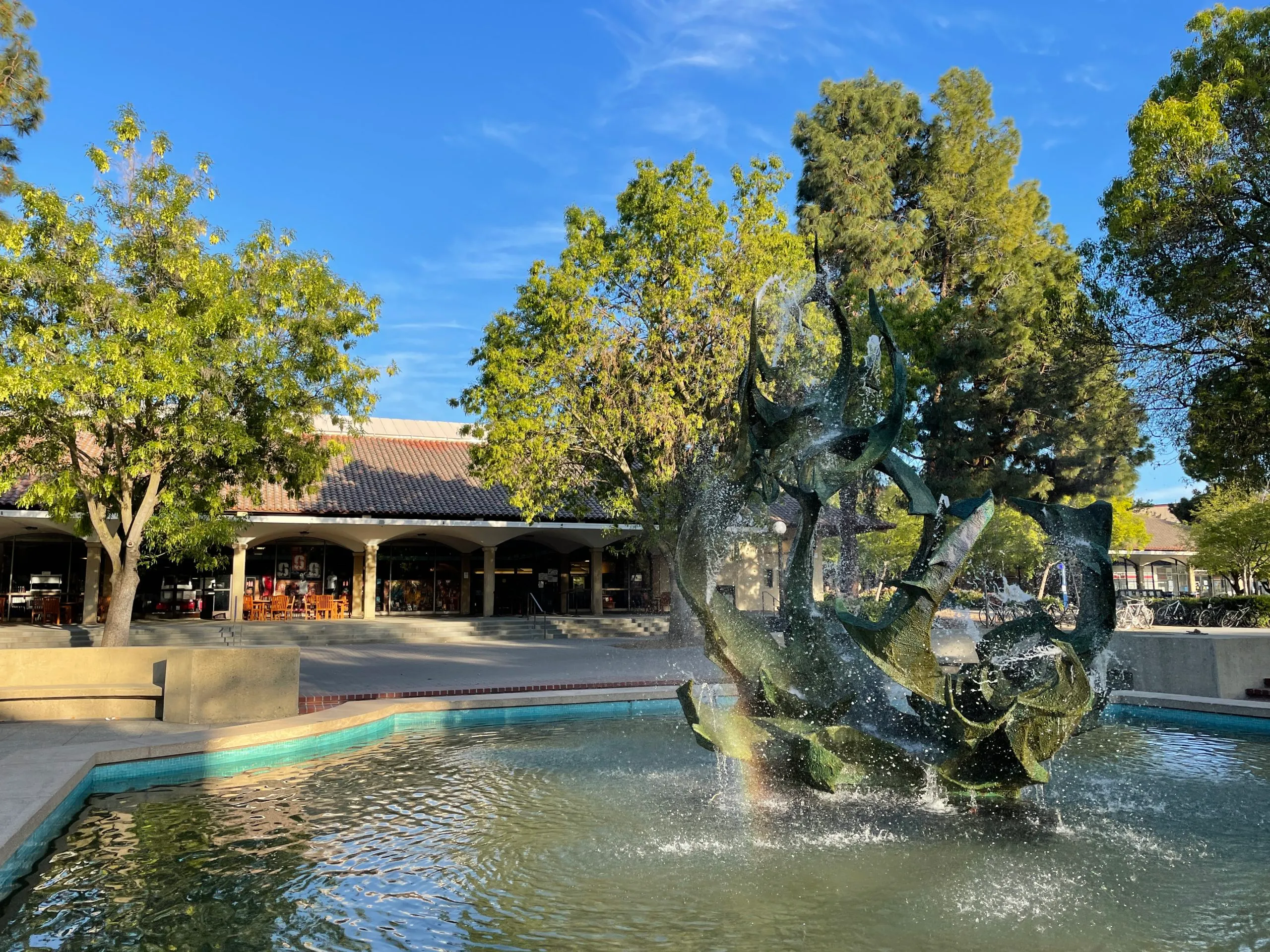It’s the day of the Big Game, and the Cardinal just cinched a last-minute victory over Cal. If you’re a Stanford student, you’ll likely celebrate by heading to the White Memorial Fountain and fountain hopping — a long-standing student tradition.
The Claw is one of Stanford’s most prominent symbols, lying at the heart of campus and the core of many Stanford rituals. On Dec. 12, The Claw’s sculptor and visionary, Aristides (Aris) Burton Demetrios, died. He was 89.
The Claw was dedicated in 1964 to two Stanford undergraduate brothers, William N. White ’49 and John B. White II ’49, who passed away before their graduation in separate accidents. In 1963, the brothers’ parents commissioned the fountain, leading Stanford to launch a selection process for the fountain’s design.
“There is a parallel here between these parents choosing to memorialize their two sons through the creation of White Memorial Plaza and the Stanfords creating the university in Leland Stanford Junior’s memory,” wrote Stanford Historic Preservation Planner Julie Cain. While both examples represent the pain of losing children and unfulfilled dreams, they also epitomize a “celebration of life,” Cain added.
Demetrios was born in 1932 in Gloucester, Mass. into a family of talented artists. His father, George Demetrios, was a classical sculptor trained by a student of Rodin. His mother, Virginia Lee Burton, wrote children’s books and is known for authoring and illustrating “Mike Mulligan and His Steam Shovel.”
Demetrios’ mother had “an incredible sense of whimsy, joy, happiness and family” while his father inspired in him a “sense of commitment to perfection,” said Demetrios’ widow, Ilene Nagel MLS ’87. The combination of these elements likely drove the greatness of his work.
Building The Claw
Demetrios’ work always held a lighthearted character, Nagel said. His goal in life, she added, was to make people feel something positive the moment they came in contact with his art.
“People would say ‘is it okay if the kids climbed the sculpture?’” she said. “Absolutely. He wanted them to enjoy it. He wanted everybody to be playful about the sculpture.”
Even though he was a graduate of Harvard College, Nagel said that Demetrios always felt like a part of the Stanford family.
Demetrios, who was “at heart a romantic,” loved hearing that The Claw was the site of many student couples’ first kiss.
After submitting three different proposals to Tresidder Union’s Cultural Arts Division, Demetrios was selected to build the 16-foot bronze and copper fountain at the center of the campus. What would seem like a daunting task to many, Demetrios took as a challenge — Nagel said that Demetrios had always been an overachiever.
“He always did very well academically, but he always tried harder than everybody else,” she said, “and so if they said you could submit one, he would submit three.”

Before starting the project, Demetrios made sure to do his homework. He spent a whole month in White Plaza studying possible angles for the sculpture and the sunlight’s influence on the surface over the course of the day. He even considered the height of students passing the sculpture during high traffic times.
Nagel said that Demetrios designed the fountain such that “the water completes the sculpture, but never in the same pattern. The water represented the fact that the two young men for whom the fountain was named, had tragically died so young, and that we would never know the paths their lives would have taken.”
The always-changing 65 water jets’ flow patterns coat every inch of the sculpture.
The production was no easy task: it took Demetrios a month to assemble The Claw with a welding torch in hand, 2,000 pounds of metal inert gas wire, a flatbed truck and a cart put all the parts in place.
“No one had ever fabricated anything like this before. It has miles of welding,” he said in an interview with Stanford News in 2010.
During the construction process, Demetrios’ two-year-old son, Eames, placed a few pennies inside the sculpture. When the water finally turned on, the hidden pennies fired out onto the plaza.
No one was hurt by the projectile pennies: “It was like being in the Blitz,” Demetrios said in a different interview. “We just roared with laughter.”
Impact of art and artist
When the fountain was installed in White Plaza in 1964, Demetrios recounted, “it was tagged The Claw within three nanoseconds.”
Just like that, the sculpture became an integral part of campus life.
“My memory of The Claw is that it meant a lot to students as a place to meet. It was also used as a campus marker,” said Wanda Corn, a professor emerita of art history.
Other Stanford community members also connected with the deeper meaning behind this sculpture. When art history professor Alexander Nemerov looks at The Claw, “I sense how delicate and fugitive it is to aspire to anything — how beautiful and worthwhile, too,” he said.
Last year, Demetrios agreed to let the Associated Students of Stanford University (ASSU) use The Claw as their logo, perhaps the ultimate sign of its profound impact on the student body.
What many Stanford students may not know is that Demetrios created countless sculptures that touched the lives of communities across California and beyond, including ones located in his hometown museum. In fact, Demetrios and Nagel made one last trip back to Gloucester prior to his death.
“It was the most amazing trip I have ever taken, Nagel said. “Every night they had a different celebration, and they referred to him as the prodigal son, and the prince coming home.”
Demetrios’ final piece was appropriately entitled “Swan Song,” which he finished three days before he passed away. In addition to his legacy at Stanford, Demetrios’ life will be honored through the Demetrios Sculpture Program at the Cape Ann Museum.
